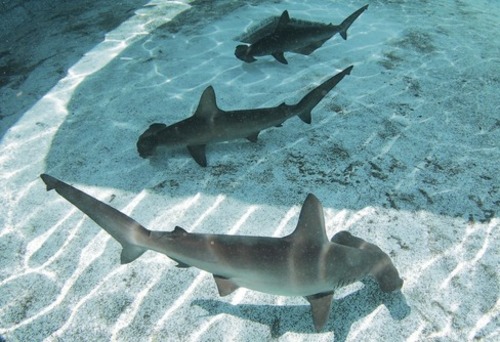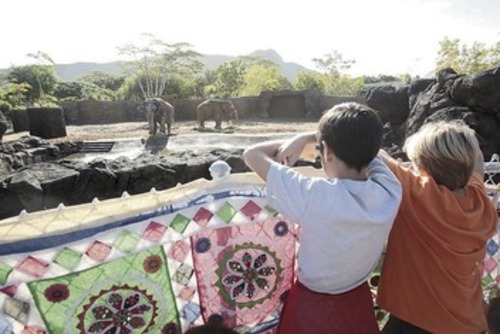Hot spots freshen up

Sea Life Park's new shark tank is the Waimanalo attraction's first new exhibit in 30 years.

Children watched as Mari and Vaigai explored their new digs when the Honolulu Zoo unveiled its new $12 million elephant habitat in December.


With the number of visitors and subsequent spending surging to double-digit highs as reported by the Hawai‘i Tourism Authority in June, discretionary income is being spread around Oahu’s attractions, restaurants, bars and nightclubs.
In anticipation of a continuing upward trend, some popular visitor venues have completed or are in the process of doing needed upgrades and makeovers. Sea Life Park, for example, debuted in June the Hawaiian Shark Tank, the park’s first new exhibit in 30 years.
Seth Casey, marketing coordinator for the Polynesian Cultural Center, spoke of two recent changes — the complete renovation of PCC’s Gateway restaurant and the introduction of new "Go Native" activities.
After about a year’s work, "the restaurant has been completely reimagined to have more of a Polynesian theme, with a menu adapted to include local favorites, as well as two dining options, an island feast buffet and a more high-end prime dining experience," Casey said.
Other renovations in the works or in the planning stages for PCC include a sense-surrounding transformation of the IMAX theater, with a soft launch in November and a grand opening two months later, and construction at the beginning of 2013 of a Polynesian marketplace that will be akin to a farmers market.
The Honolulu Zoo boasts a new elephant exhibit — "a real milestone" according to director Manuel Mollinedo — and a new front entrance to welcome its guests.
Don't miss out on what's happening!
Stay in touch with breaking news, as it happens, conveniently in your email inbox. It's FREE!
"Attendance last year, before the new projects, was right around 600,000," he said, "which made it the fourth-most-visited venue on the island. This year, we’re expecting around 660,000."
Expected capital improvement money from the city will go to building a new reptile area, which Mollinedo said is probably 21⁄2 years away. "We want to bring in some new animals, too.1 Our collection has to be re-energized, because some of them are very geriatric and with age-related diseases. Younger and different animals should help in keeping our attendance growing."
Valerie King, Kualoa Ranch’s director of marketing and business development, said current attendance numbers from the just-completed fiscal year "are running at about the same percent increase," with 2010 attendance around 289,000 and 2011 at 352,000.
"As of May, we started a new dinner and show, ‘Legends of Kualoa,’ tied into our afternoon tours, and something in the works that our kamaaina should be interested in is a more active adventure tour on horseback and ATVs."
King said also in the works is the opening of the World War II bunker that currently houses movie-site memorabilia. "We plan on opening up the full bunker, add some new movie props and restore the other half and fill it with WWII memorabilia.
"We’re real pleased with our numbers. On a list of paid Hawaii attractions, we’re No. 3 behind Hanauma Bay and Volcanoes National Park on the Big Island."
Despite the recent closings of popular nightspots Apartment3 and The Shack Waikiki, Bill Comerford, spokesman for the Hawaii Bar Owners Association, remains relatively optimistic.
"In order for the industry to remain healthy, there needs to be a balance in an understanding from legislators that a multitude of laws, such as the enforcement of smoking bans and noise regulation, sometimes adversely affects how our places operate.
"Our big concern is that our industry continues to cater to our tourists. I figure that 90 percent of our market is made up of couples, so it’s important to keep their business coming.
"The trends look good. People still want to have a good time, no matter the economy."
As the president of a business that owns the Irish Rose Saloon, Kelley O’Neil’s, O’Toole’s Irish Pub and Anna O’Brien’s (formerly Anna Bannana’s), Comerford said, "I try to cater to thirds, which is one-third locals, one-third military and one-third tourists.
"I try to move with the public tastes and trends in music, alcohol and beer. It’s a great industry, fun to work in, and we try to be responsible."
The health of the economy and changes in taste also play an important role in the viability of Hawaii’s restaurants.
According to statistics based on federal government data and National Restaurant Association research, Hawaii’s restaurants are projected to register $3.5 billion in sales this year, while employing 79,400 people.
"We’re one of the biggest employers in Hawaii, next to the state and federal," said Thomas Jones of Gyotaku and new chairman of the Hawaii Restaurant Association.
"With the trend of people eating more outside of the home, the industry continues to grow. With lots of national chains moving into the market in and around resort areas, it certainly raises the bar for small and mid-size restaurants. But demand is steady and the prospects for the business are good."



